Portal:London/Featured biography
| This Wikipedia page has been superseded by Portal:London, and it is retained primarily for historical reference. |
| Note: Article entries are now being transcluded directly on the main portal page. However, this page should be retained for historical reference. |
Featured biographies

These are featured biographical articles related to the London which appear on Portal:London.
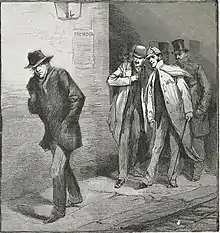
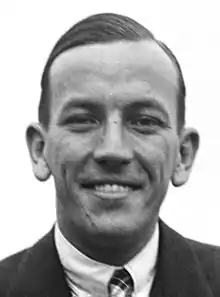

.jpg.webp)
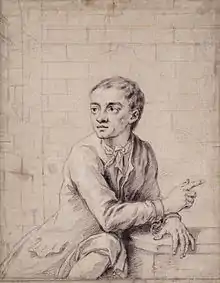
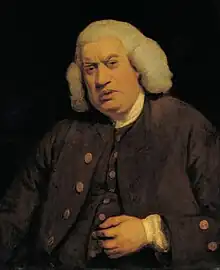


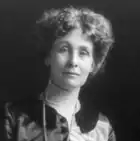
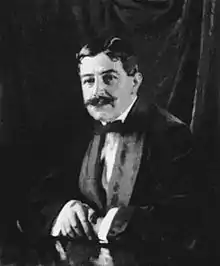
.png.webp)
Mellitus was the first Bishop of London, the third Archbishop of Canterbury, and a member of the Gregorian mission sent to England to convert the Anglo-Saxons. He arrived in 601 AD with a group of clergymen sent to augment the mission, and was consecrated as Bishop of London in 604. Mellitus was the recipient of a famous letter from Pope Gregory I known as the Epistola ad Mellitum, preserved in a later work by the medieval chronicler Bede, which suggested the conversion of the Anglo-Saxons be undertaken gradually and integrate pagan rituals and customs. In 610, Mellitus returned to Italy to attend a council of bishops, and returned to England bearing papal letters to some of the missionaries. Mellitus was exiled from London by the pagan successors to his patron, King Sæberht of Essex, following the latter's death around 616. King Æthelberht of Kent, Mellitus' other patron, died at about the same time, forcing him to take refuge in Gaul. Mellitus returned to England the following year, after Æthelberht's successor had been converted to Christianity, but he was unable to return to London, whose inhabitants remained pagan. Mellitus was consecrated as Archbishop of Canterbury in 619. During his tenure, he was alleged to have miraculously saved the cathedral, and much of the town of Canterbury, from a fire. After his death in 624, Mellitus was revered as a saint.

David Bowie (8 January 1947 – 10 January 2016), born David Robert Jones, was an English musician, actor, record producer and arranger. A major figure for over four decades in the world of popular music, Bowie was widely regarded as an innovator, particularly for his work in the 1970s. He was known for his distinctive voice and the intellectual depth and eclecticism of his work.
Bowie first caught the eye and ear of the public in July 1969, when his song "Space Oddity" reached the top five of the UK Singles Chart. After a three-year period of experimentation he re-emerged in 1972 during the glam rock era with the flamboyant, androgynous alter ego Ziggy Stardust, spearheaded by the hit single "Starman" and the album The Rise and Fall of Ziggy Stardust and the Spiders from Mars. In 1975, Bowie achieved his first major American crossover success with the number-one single "Fame" and the hit album Young Americans. The sound constituted a radical shift in style that initially alienated many of his UK devotees. He then confounded the expectations of both his record label and his American audiences by recording the minimalist album Low (1977)—the first of three collaborations with Brian Eno over the next two years. The so-called "Berlin Trilogy" albums all reached the UK top five and garnered lasting critical praise.
After uneven commercial success in the late 1970s, Bowie had UK number ones with the 1980 single "Ashes to Ashes", its parent album Scary Monsters (and Super Creeps), and "Under Pressure", a 1981 collaboration with Queen. He then reached a new commercial peak in 1983 with Let's Dance, which yielded several hit singles. Throughout the 1990s and 2000s, Bowie continued to experiment with musical styles, including blue-eyed soul, industrial, adult contemporary, and jungle. His last recorded album, Blackstar, was released on his 69th birthday two days before his death. In the BBC's 2002 poll of the 100 Greatest Britons, Bowie was placed at number 29. In 2004, Rolling Stone ranked him 39th on their list of the "100 Greatest Artists of All Time", and 23rd on their list of the best singers of all-time.
Alice Ayres (1859–1885) was an English nursemaid honoured for her bravery in rescuing the children in her care from a house fire. Ayres was a household assistant and nursemaid to the family of her brother-in-law and sister, Henry and Mary Ann Chandler. The Chandlers owned an oil and paint shop in Union Street, Southwark, then just south of London, and Ayres lived with the family above the shop. In 1885 fire broke out in the shop, and Ayres rescued three of her nieces from the burning building, before falling from a window and suffering fatal injury.
Britain, in the wake of the Industrial Revolution, experienced a period of great social change in which the rapidly growing news media paid increasing attention to the activities of the poorer classes. The manner of Ayres' death caused great public interest, with large numbers of people attending her funeral and contributing to the funding of a memorial. Shortly after her death, she underwent what has been described as a "secular canonisation", being widely depicted in popular culture and, although very little was known about her life, widely cited as a role model. Various social and political movements promoted Ayres as an example of the values held by their particular movement. The circumstances of her death were distorted to give the impression that she was an employee willing to die for the sake of her employer's family, rather than for children to whom she was closely related. In 1902 her name was added to the Memorial to Heroic Self Sacrifice and in 1936 a street near the scene of the fire was renamed Ayres Street in her honour.
The case of Alice Ayres came to renewed public notice with the release of Patrick Marber's 1997 play Closer, and the 2004 film based on it. An important element of the plot revolves around a central character who fabricates her identity based on the description of Ayres on the Memorial to Heroic Self Sacrifice, with some of the film's key scenes shot around the memorial.
Harold Pinter (1930–2008) was a Nobel Prize-winning English playwright, screenwriter, director and actor. One of the most influential modern British dramatists, his writing career spanned more than 50 years. His best-known plays include The Birthday Party (1957), The Homecoming (1964), and Betrayal (1978), each of which he adapted to film. His screenplay adaptations of others' works include The Servant (1963), The Go-Between (1970), The French Lieutenant's Woman (1981), The Trial (1993), and Sleuth (2007). He also directed or acted in radio, stage, television, and film productions of his own and others' works.
Pinter was born and raised in Hackney, east London, and educated at Hackney Downs School. He was a sprinter and a keen cricket player, acting in school plays and writing poetry. He attended the Royal Academy of Dramatic Art but did not complete the course. He was fined for refusing National Service as a conscientious objector. Subsequently, he continued training at the Central School of Speech and Drama and worked in repertory theatre in Ireland and England. In 1956 he married actress Vivien Merchant and had a son, Daniel born in 1958. He left Merchant in 1975 and married author Antonia Fraser in 1980.
Pinter's career as a playwright began with a production of The Room in 1957. His second play, The Birthday Party, closed after eight performances, but was enthusiastically reviewed by critic Harold Hobson. His early works were described by critics as "comedy of menace". Later plays such as No Man's Land (1975) and Betrayal (1978) became known as "memory plays". He appeared as an actor in productions of his own work on radio and film. He also undertook a number of roles in works by other writers. He directed nearly 50 productions for stage, theatre and screen. Pinter received over 50 awards, prizes, and other honours, including the Nobel Prize in Literature in 2005 and the French Légion d'honneur in 2007.
Despite frail health after being diagnosed with oesophageal cancer in December 2001, Pinter continued to act on stage and screen, last performing the title role of Samuel Beckett's one-act monologue Krapp's Last Tape, for the 50th anniversary season of the Royal Court Theatre, in October 2006. He died from liver cancer on 24 December 2008.
Edmund Evans (1826–1905) was a prominent English wood engraver and colour printer during the Victorian era. Evans specialized in full-colour printing, which became popular in the mid-19th century. He employed and collaborated with illustrators such as Walter Crane, Randolph Caldecott, Kate Greenaway and Richard Doyle to produce what are now considered to be classic children's books. Although little is known about his life, he wrote a short autobiography before his death in 1905 in which he described his life as a printer in Victorian London.
After finishing an apprenticeship, Evans went into business for himself. By the early 1850s, he had established a reputation as a printer of covers for a type of cheap novels known as yellow-backs. In the early 1860s, he began to print children's toy books and picture books in association with the printing house Routledge and Warne. His intention was to produce books for children that were beautiful and inexpensive. For three decades he produced multiple volumes each year, first illustrated by Crane, and later by Caldecott and Greenaway.
Evans used a woodblock printing technique known as chromoxylography, which was used primarily for inexpensive serialised books and children's books requiring few colours, so as to maximize profits. However, chromoxylography allowed a variety of hues and tones to be produced by mixing colours. The process was complicated and required intricate engraving to achieve the best results. Evans possessed a meticulous eye for detail and used a hand-press and as many as a dozen colour blocks for a single image. He went on to become the preeminent wood engraver and colour printer in Britain during the second half of the 19th century.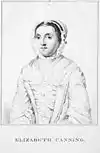
Elizabeth Canning (married name Treat; 1734–1773) was an English maidservant who claimed to have been kidnapped and held against her will in a hayloft for almost a month. She ultimately became central to one of the most famous English criminal mysteries of the 18th century.
She disappeared on 1 January 1753, before almost a month later returning to her mother's home in Aldermanbury in the City of London, emaciated and in a "deplorable condition". After being questioned by concerned friends and neighbours she was interviewed by the local alderman, who then issued an arrest warrant for Susannah Wells, the woman who occupied the house in which Canning was supposed to have been held. There Canning identified Mary Squires as another of her captors, prompting the arrest and detention of both Wells and Squires. Local magistrate Henry Fielding became involved in the case, taking Canning's side. Further arrests were made and several witness statements were taken, and Wells and Squires were ultimately tried and found guilty—Squires of the more serious and potentially deadly charge of theft.
However, the trial judge and Lord Mayor of London Crisp Gascoyne was unhappy with the verdict and began his own investigation. He spoke with witnesses whose testimony implied that Squires and her family could not have abducted Canning, and he interviewed several of the prosecution's witnesses, some of whom recanted their earlier testimony. He ordered Canning's arrest, following which she was tried and found guilty of perjury. Squires was pardoned, and Canning sentenced to one month's imprisonment and seven years of transportation.
Elizabeth Canning's case pitted two groups of believers against one another: the pro-Canning Canningites, and the pro-Squires Egyptians. Crisp Gascoyne was openly abused and attacked in the street, while interested authors waged a fierce war of words over the fate of the young, often implacable maid. She died in British America in 1773, but the mystery surrounding her disappearance remains unsolved.
Henry Spencer Moore (1898–1986) was an English sculptor and artist. He was best known for his semi-abstract monumental bronze sculptures which are located around the world as public works of art.
His forms are usually abstractions of the human figure, typically depicting mother-and-child or reclining figures. Moore's works are usually suggestive of the female body, apart from a phase in the 1950s when he sculpted family groups. His forms are generally pierced or contain hollow spaces. Many interpreters liken the undulating form of his reclining figures to the landscape and hills of his birthplace, Yorkshire.
Moore was born in Castleford, the son of a coal miner. He became well-known through his carved marble and larger-scale abstract cast bronze sculptures, and was instrumental in introducing a particular form of modernism to the United Kingdom. His ability in later life to fulfill large-scale commissions made him exceptionally wealthy. Yet he lived frugally and most of the money he earned went towards endowing the Henry Moore Foundation, which continues to support education and promotion of the arts.